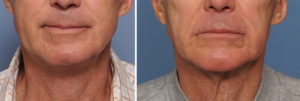Background: Jawline augmentation today usually refers to enhancement of its three primary aesthetic points, the chin and two jaw angles. There are a variety of standard preformed chin and jaw angle implants to achieve this effect and, with proper implant style and size, satisfactory results can be achieved.
But beyond the challenge of selecting the right implant style and size for three different bony jaw areas, there is the need to place them in the proper bony location to exert their desired external effects. The latter is often taken for granted by the patient but not by the surgeon. Placing three implants at different locations on the jawline without being able to reference one to the other due to the limitations of incisional access makes this part of the operation more difficult than it seems. This is far more challenging than placing a single chin implant or even paired cheek implants.
As a result the incidence of implant malposition and asymmetry is not all that uncommon in a three implant approach to jawline augmentation. This risk is magnified when the patient has pre-existing jaw angle bony asymmtetry which may or may not have been recognized before surgery.



There are many patients in whom standard chin and jaw angle implants work well. But it is not easy to successfully place three independent jaw implants in a perfectly symmetric fashion. Even with a lot of surgical experience it can still happen. When a three-piece jaw implant approach has not been successful, a custom jawline implant will offer improved results by its ‘one implant’ design.
Highlights:
1) Total jawline augmentation done with standard implants has a relaltively high risk of malposition/asymmetry of at least one of the implants since there are three implants used.
2) A 3D CT scan can confirm standard jawline implant positions as well as be used for a one-piece total jawline implant.
3) Indwelling implants provide dimensional guidelines in designing a custom jawline implant.
Dr. Barry Eppley
Indianapolis, Indiana





